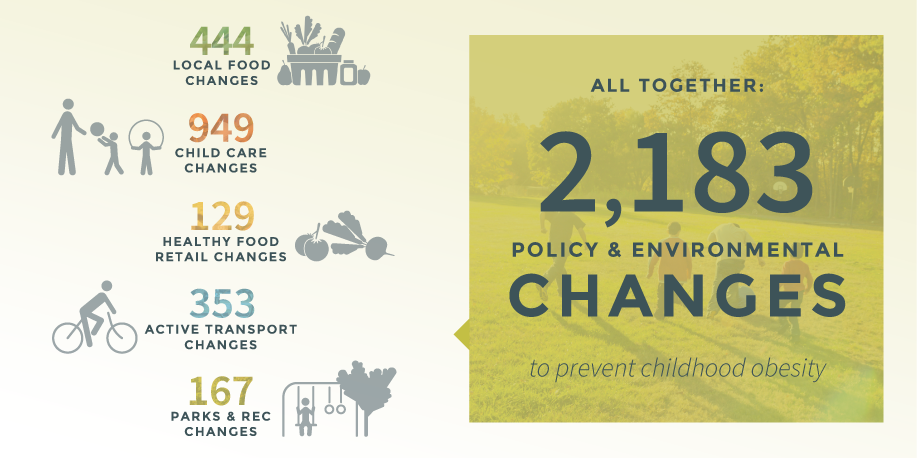Infographics: Worth the Effort?
Did you know that the average shelf life of a tweet or Facebook post is less than three hours? Grabbing your audience’s attention is tricky with the ever-increasing speed of information. You have compelling data and a story to tell, but your message can get lost in a crowded feed. How can you make it stand out?
As far as Nonprofit Tech for Good is concerned, there’s no debate: “From print fundraising appeals to digital annual reports to compelling storytelling through tweets and status updates, the social science of online behavior confirms again and again that messages are most effectively communicated through images.” [1]
One trend we’re seeing is the use of infographics, ranging from simple charts to a long and complicated string of graphics. Active Living By Design’s communications team recently published our own infographic to share high-level findings from Healthy Kids, Healthy Communities (HKHC), a significant, five-year childhood obesity prevention initiative. We considered three simple questions in the process. Read on to see how Risa Wilkerson, our Marketing and Communications Director, and Sarah Moore, our Communications Coordinator, answered them.
Q1: Is it worth the time and effort?
Risa: We were creating graphs for Growing a Movement and loved how effective they were for conveying the information. We knew we wanted additional graphics for future presentations, so developing the infographic would help us with those needs. Our timeline for finalizing all dissemination products was tight, however, so we probably wouldn’t have pushed to include an infographic if we didn’t have Sarah on staff. Her excellent design skills and eye for layout meant we had the internal capacity to add the infographic with our final report. You have to balance capacity with what is nice to have and what is necessary to have.
Sarah: For even a well-seasoned social media user, the constant stream of information can be overwhelming. A reader may scroll through to get a general feel for an online conversation without actually engaging more deeply in one topic. This makes a great case for using an infographic, because an intuitively legible image that communicates at a glance will slow readers down long enough to let their eyes linger on your message. That pause can be enough to spark curiosity and make a meaningful connection.
Q2: Will the infographic take over the real story?
Risa: Knowing that people tend to read headlines and believe they understand the whole story, we talked about whether the infographic would unintentionally become that “headline tells all” and decrease readership of the full report. However, we also know that a good teaser can entice more people to take time to dig deeper, so we crafted the infographic and its promotion with the intention of it being an invitation to the more comprehensive story.
Sarah: When designing the infographic, I thought of it as a teaser to the full report: something that would evoke an emotional response in our audience and make them want to understand the whole story. With so much great data to work with, it was tempting to show everything—instead, I made simple icons to represent groups about which the full report goes into detail, and was careful to refer back to the report in each section.
Q3: How can the infographic support overall communications strategies?
Risa: An infographic should tell a clear and compelling story, not just provide a list of facts. The “so what” is critical, or it may not be worth the development time. The jury is out, yet, about how this infographic may have been useful to others and/or increased the visibility of our full report. But it certainly has resulted in some social media engagement, and we believe it will be useful in future communication efforts.
Sarah: An organization’s voice is crafted through every aspect of its communications, and imagery is especially powerful. Decisions about color, typography, photography and icons can cue in an audience about organizations’ attitudes and beliefs. Making this infographic gave ALBD a chance to combine all those elements into one shareable format. Each time it’s shared, it tells HKHC’s story and communicates ALBD’s vision through fresh, optimistic colors, playful icons, and concise, meaningful data.
We need your help!
Help us share these results—use the teaser images below on social media or share this blog post. And if you’re in a hurry, grab this sample tweet!
Growing a #cultureofhealth movement with 2,183 policy & environmental changes http://bit.ly/HKHCinfographic @ALBDorg @RWJF


[1] http://www.nptechforgood.com/2014/04/05/5-trends-in-nonprofit-infographic-design/
